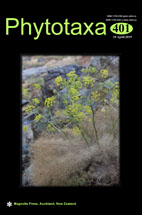Abstract
A study was made of the ultrastructural variation in a group of conopeate Nitzschia species, primarily marine species from Guam but also including one freshwater species from Costa Rica. Fourteen new species are described: Nitzschia alcyoneae, Nitzschia asteropeae, Nitzschia carahii, Nitzschia celaenoae, Nitzschia dagmannii, Nitzschia electrae, Nitzschia guamensis, Nitzschia jordanii, Nitzschia lascrucensis, Nitzschia maiae, Nitzschia meropeae, Nitzschia schefterae, Nitzschia spathulatoides, and Nitzschia taygeteae. The valves in all these taxa had a central raphe-sternum on a raised keel; from the keel arise silica flaps, the conopea, and the valve face was depressed below the conopea to form conopeal canals. The valve surface was thus differentiated into three regions, in which the areola pattern sometimes differed: the exposed valve face, the valve depression, and the peri-raphe zone, i.e., the exposed part of the keel wall between the conopeum and the raphe-sternum. We refer to this suite of characters as the tholophora (canopy-bearing) morphology. In one species, N. maiae sp. nov., the conopea occurred only at the apex and there was no valve depression. Thirty-eight morphological characters were used in addition to the usual morphometric data (length, width, densities of striae and fibulae); these included, inter alia, a remarkable range of areola shapes on the three valve regions and the copulae—oval/circular pores, transapical slits, longitudinal slits, small pores fields, continuous pores fields, and larger quadrate pores closed by hymenes or cribra; the extent of the conopea along the valve; the presence of longitudinal ribs on the valve, conopea, or copulae; and the extent of internal development of silica below the striae. Phylogenetic analysis of gene sequences from six species was entirely congruent with analysis of morphological characters.

